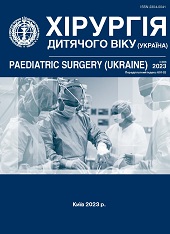Acute necrotizing pneumonia and pyofibrinothorax in an experiment
DOI:
https://doi.org/10.15574/PS.2023.80.21Keywords:
acute destructive pneumonia, pyofibrinothorax, microflora, growing organismAbstract
Nowadays, the problem of diagnosis and treatment of purulent-destructive diseases of the bronchopulmonary system in children remains relevant, that is connected with a large number of pulmonary-pleural forms and complications of acute necrotizing pneumonia.
Purpose - to establish the correlation of changes in lung tissue and the pleural cavity of a growing organism, depending on the causative agents of pneumonia, elucidation and study of the mechanisms of pyofibrothorax formation and development.
Materials and methods. The characteristic features of histopathological tissue changes in the lung parenchyma and adjacent tissues have been analyzed (visceral and parietal pleura, adhesion formation sections) of 45 immature laboratory rats, divided into 5 groups: the control group (intact animals), the Group 2 - contaminated with Klebsiella pneumoniae, the Group 3 - Staphylococcus aureus, the Group 4 - Candida albicans and the Group 5 with mixed flora (Klebsiella pneumoniae+Staphylococcus aureus) adding fungal infection (Candida albicans).
Results. It was proved that the formation of a massive pyofibrinothorax is enhanced by mixed flora with the addition of fungi, that is more pronounced in the fifth series (group) of the experiment. Taking into account the data obtained experimentally, we consider whether fungi are Lukianenkoobtained in cultures of patients’ flora, they should be classified as a risk group of fibrothorax formation.
Conclusions. Morphological changes of tissues under the influence of the infectious agent reached their maximum on the ninth day of the experiment (p<0.05). The pattern of necrotizing pneumonia is more pronounced in the Group 5 of experimental animals, which morphologically manifests itself in a more massive inflammatory infiltration (mostly due to rod- and segmented-nuclear neutrophils), foci of destruction and abscessation of the lung parenchyma and has a direct association with the polymicrobial etiology of the disease (Klebsiella pneumoniae+Staphylococcus /taureus+Candida albicans) (p<0.05). The formation of a massive pyofibrinothorax is enhanced by mixed flora, especially with the addition of fungi.
The study was carried out in accordance with the principles of the European Convention for the Protection of Vertebrate Animals used for Experimental and Other Scientific Purposes, as well as the law of Ukraine. The research protocol was approved by the Local Ethics Committee of the institution mentioned in the article.
No conflict of interests was declared by the authors.
References
Buteiets IF, Hryhorova MV, Zhuk NO. (2018). Pytannia likuvannia destruktyvnykh pnevmonii u ditei. Medytsyna tretoho tysiacholittia: zbirnyk tez mizhvuzivskoi konferentsii molodykh vchenykh ta studentiv, m. Kharkiv, 24 sichnia 2018 r. Kharkiv: KhNMU: 134-135.
Clark JE, Hammal D, Hampton F, Spencer D, Parker L. (2007). Epidemiology of community-acquired pneumonia in children seen in hospital. Epidemiol Infect. 135: 262-269. https://doi.org/10.1017/S0950268806006741; PMid:17291362 PMCid:PMC2870565
De Benedictis FM, Kerem E, Chang AB, Colin AA, Zar HJ, Bush A. (2020). Complicated pneumonia in children. Lancet. 396 (10253): 786-798. https://doi.org/10.1016/S0140-6736(20)31550-6; PMid:32919518
Kelemen IYa, Savula MM, Didyk VS. (2018). The use of endobronchial valve occlusion in the comprehensive treatment of severe purulent-destructive pulmonary processes complicated by bronchopleural fistula. Paediatric Surgery. Ukraine. 4 (61): 42-45. https://doi.org/10.15574/PS.2018.61.42
Kosulnikov СО, Snisar AV, Tarnopolsky SO, Bessedin OM, Karpenko СІ, Kravchenko KV. (2018). Experience of using vacuum-therapy in thoracic surgery Paediatric Surgery. Ukraine. 4 (61): 55-60. https://doi.org/10.15574/PS.2018.61.55
Le Roux DM, Zar HJ. (2017). Community-acquired pneumonia in children - a changing spectrum of disease [published correction appears in Pediatr. Radiol. 2017. 47 (13): 1855]. Pediatr. Radiol. 47 (11): 1392-1398. https://doi.org/10.1007/s00247-017-3827-8; PMid:29043417 PMCid:PMC5608782
Senstad AC, Surén P, Brauteset L, Eriksson JR, Høiby EA, Wathne K. (2009). Community-acquired pneumonia (CAP) in children in Oslo, Norway. Acta Paediatr. 98: 332-336. https://doi.org/10.1111/j.1651-2227.2008.01088.x; PMid:19006533
Verkhovna Rada Ukrainy. (1986). Yevropeiska konventsiia zakhystu khrebetnykh tvaryn, yaki vykorystovuiutsia v eksperymentalnykh ta inshykh tsiliakh. URL: https://zakon.rada.gov.ua/laws/show/994_137#Text.
Weigl JA, Puppe W, Belke O, Neususs J, Bagci F, Schmitt HJ. (2005). Population-based incidence of severe pneumonia in children in Kiel, Germany. Klin Padiatr. 217: 211-219. https://doi.org/10.1055/s-2004-822699; PMid:16032546
Yun KW, Wallihan R, Juergensen A, Mejias A, Ramilo O. (2019, Jul). Community-Acquired Pneumonia in Children: Myths and Facts. Am J Perinatol. 36 (S2): S54-S57. Epub 2019 Jun 25. https://doi.org/10.1055/s-0039-1691801; PMid:31238360
Downloads
Published
Issue
Section
License
Copyright (c) 2023 Paediatric Surgery (Ukraine)

This work is licensed under a Creative Commons Attribution-NonCommercial 4.0 International License.
The policy of the Journal “PAEDIATRIC SURGERY. UKRAINE” is compatible with the vast majority of funders' of open access and self-archiving policies. The journal provides immediate open access route being convinced that everyone – not only scientists - can benefit from research results, and publishes articles exclusively under open access distribution, with a Creative Commons Attribution-Noncommercial 4.0 international license(СС BY-NC).
Authors transfer the copyright to the Journal “PAEDIATRIC SURGERY.UKRAINE” when the manuscript is accepted for publication. Authors declare that this manuscript has not been published nor is under simultaneous consideration for publication elsewhere. After publication, the articles become freely available on-line to the public.
Readers have the right to use, distribute, and reproduce articles in any medium, provided the articles and the journal are properly cited.
The use of published materials for commercial purposes is strongly prohibited.

